January 15 and May 28 of 1970 in Knoxville Tennessee, two days that altered the course of a life. One through no fault of my own and the other by my own design as a result of the first.
Listening to audio books while cycling helps me stay well read and passes the time. Imagine my surprise last month as I listened to Rick Perlstein's NIXONLAND and heard my name coming through the headphones. I almost fell off the bike.
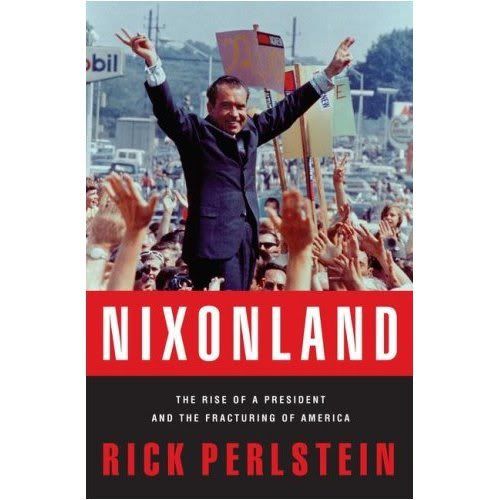
Hearing Perlstein reference an event from forty years in my past got me to thinking about events that shaped and changed my life so I began to do some research to see what I could find to share about the experience.
If you have any interest in the trials of a liberal Democrat born into a Republican stronghold follow me below and see what I produced for you as a result of Mr Perlstein's prodding. A lot of work went into this and there is a lot here. I only hope I've done justice to two truly remarkable events in a truly remarkable time. Thank you for reading.
In order to understand the impact of this place you need to know a bit about Knoxville politics and history. Knoxville is the urban center of the Second Congressional District of Tennessee. This District had never seen a Democrat in that office. In 60 years of my 64 year lifespan the office has been held by two families. Howard Baker Sr served from 1950 until his death when his wife Irene served out his term in 1965, John Duncan Sr from 65 to 88 and his son John Duncan Jr from 1988 until the present. Knoxville is the capitol of conservative Republican East Tennessee and home to the University of Tennessee where these events took place.
2 events in early 1970 resulted in a radical change to the course of my life at age 24. - the first was marked by my designation as the KNOXVILLE 22nd and the 2nd was a visit to the UT Campus by Richard Nixon at the invitation of the Reverend Billy Graham.
This week on FACEBOOK a friend posted pictures of the Jan 15, 1970 police riot that took place outside the Administration Building on the famous UT Hill. In the picture below a crowd is gathered on the west side of Ayers Hall observing the action in front of the Austin Peay administration building across the street. The guy with a raised hand below the red line is me.

Evidently observing a demonstration and raising one's hand as seen in the picture above is enough to merit indictment on the FELONY charge of INCITING TO RIOT in Republican East Tennessee.
Prior to these two early 1970 events I had been a mainstream college Democrat participating in campus politics of the kind that elected student body & class Presidents and got fraternity brothers in positions like Homecoming Chairman and CARNICUS advisory committee. As Freshman Class President I even organized a "Support the Troops" rally in front of the Student Center.
HOW I BECAME THE KNOXVILLE 22ND
In early February 1970 I got a visit from my father's law partner at my apartment on the UT Campus. It came as quite a surprise. Jim Jones was a young lawyer in Dad's law firm who said he was sent because my father thought he could 'relate' to me better. His message was that I had been indicted by a grand jury on the Felony charge of INCITING A RIOT for my participation in a demonstration on January 15th. To say I was shocked is considerable understatement and this is why.
I had traveled to Miami with my younger brother's band over the Christmas and New Year's holiday to assist the band as a manager/sound mixer. My brother and I returned to Knoxville in early January and I decided to enroll at UT to finish up a couple of courses required to complete my degree even though I had truly been lucky in the first draw of the new draft lottery in December. For the first time in years I was not required to attend school to avoid the draft. But on Jan 15 I went up to the Hill to register for classes and there encountered a relatively small group of students listening to speeches by guys I later came to know as Peter Kami, Gus Hadorn, and Carroll Bible. They were protesting the decision by the student faculty selection committee to name Dr Edward J. Boling as the next UT President.
I had known Dr Boling quite well for some time because I worked for him as the student in charge of the Alumni Giving program and my family was close friends with the Boling family. I understood that the students and some faculty were upset with the choice because they had been named to the selection committee and they wanted an academic person to be President. Boling was a development person who mainly raised money and helped build the physical part of the university. Over their specific objections Boling was named making their participation on a selection committee a sham.
The speeches were not too exciting until Peter Kami an anemic looking guy with a Brazilian accent and wire rimmed granny glasses perched on his nose challenged Dr. Boling to an arm wrestling match for the office of President. It was funny because Peter's arm was pencil like and his lack of imposing physical attributes was quite apparent. Few would have bet on him prevailing in such a contest.

This detail should show you that the issue involved in this small protest was rather minor and not emotionally charged like the war or civil rights protests. There was no reason it should have resulted in arrests and serious disruption to several lives.
The small group grew smaller and weary as they began to drift away so a long haired fellow (Gus Hadorn I believe) jumped on the stump and suggested that the participants enter the admin building and "gum up the works" by standing in the Drop and Add lines. This suggestion failed miserably in rallying the troops and they continued to drift toward the stairs leading down the Hill.
Then two amazing things conspired to alter personal histories:
First the bells rang marking an end to that period of classes and several hundred students poured from nearby classroom buildings causing a temporary huge increase of people in the area, and 2) there appeared on the Hill a phalanx of UT Campus Police in full riot gear - White storm trooper helmets, clear acrylic shields, and large riot batons. The 30 men marched in a V formation toward the group at the administration building from the south with shield and helmets glistening in the bright Winter sun. What the speeches failed to do - inspire the interest of the students - the storm troopers managed in an instant. Now the students were very interested although only a few had any idea what the fuss was all about.

Over the next 30 minutes about 30 of the students gathered at the door to the admin building demanding to be admitted and a few hundred more stood around waiting to see what would happen next. An announcement over a loudspeaker demanding everyone clear the area was met with derision as students insisted they had the right to free assembly. A couple of the guys nearest the door were pushed an a single diamond shaped leaded pane of glass in a window broke. The troops formed a semicircle around the walkway and front door but people came and went in and out of that line with little resistance. Eventually an ultimatum was issued and a deadline set to clear the area by then "or else" and we got to wait and watch the clock tick down.
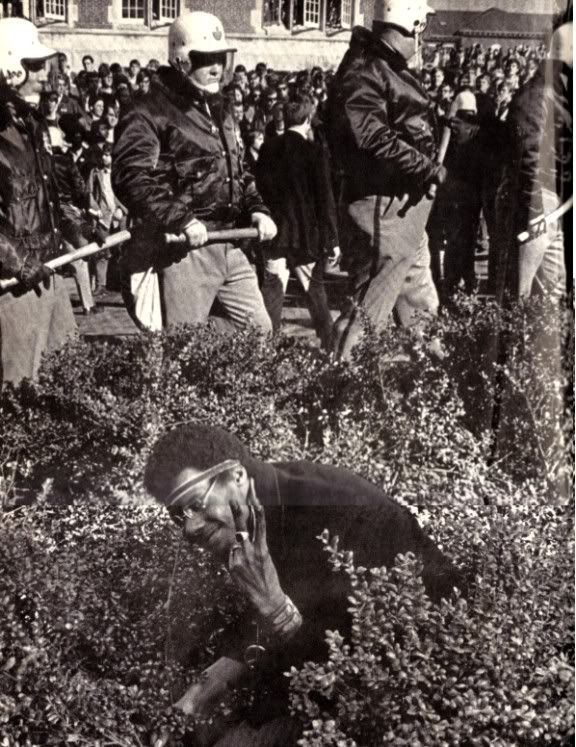
When the appointed time was reached the front doors to the administration building opened and out poured some 100 Knoxville Police in full riot gear with gas masks and dogs. We now had over 130 police for around 30 student demonstrators and maybe 300 observers. The cops grabbed 15 or 20 of the closest people and everyone else headed off the hill in a hurry. Tennessee is not Columbia or Berkeley.
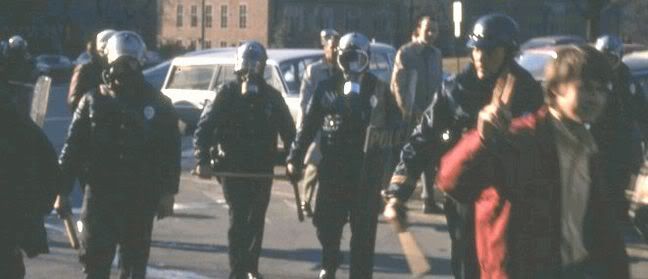
While I was on the Hill that Jan afternoon I spoke to several fraternity brothers and a number of other students I knew. I had been President of Phi Sigma Kappa Fraternity, An elected representative from the liberal arts college in the student government, a member of the student tribunal, and President of the Freshman Class during the previous 5 years. In 1968 I had been selected as a national student field secretary for my Fraternity and traveled the country for a year in that capacity. I had then gone to the Law School for one year before deciding that law was not for me. I knew many of the students who were in the area while being a truly ambivalent and objective observer who was not a participant.
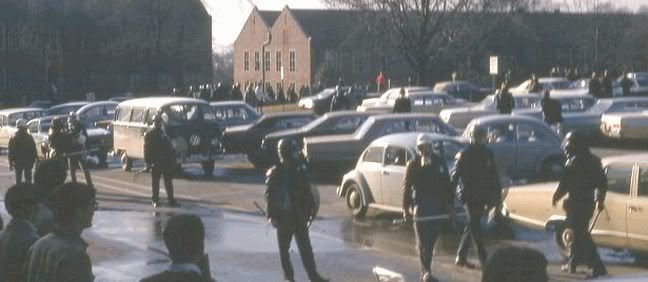
My year working for the fraternity had taken me to UC Berkeley and Stanford in the west where student activists were prevalent and relatively powerful. I had been to universities in New York, Pennsylvania, and New England in the East and the students were quite active ways seldom seen in the South. One thing I knew beyond all doubt was that there was little hope any similar student activism would thrive at the University of Tennessee.
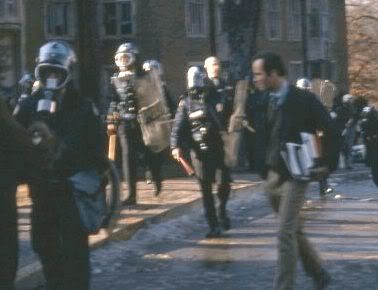
I really was shocked at the police response. What were 100 city police officers in riot gear doing inside the administration building? I thought for certain they had to be there prior to the start of the gathering. It would have been nearly impossible for them to arrive later because there was no way inside that would not have revealed their entry to some students in the crowd. Why would the administration decide on such a massive police response to such a small gathering of students making speeches about their discontent with the selection of a President? There was never any credible threat to the security of the administration building. The 30 Campus police could easily handle that small part of the 'crowd' that might try to force their way inside.
In the days that followed the event I began to spend some time trying to help raise money for the defense of those students who had been arrested. Among them were two fraternity brothers who also had nothing to do with the demonstration. They like me had watched the events out of curiosity. One of them is now a staunch Republican - a stance I find difficult to believe given his experience. The other passed away some time ago. Both were mild mannered southern guys who definitely did not fit the "radical" mode or mindset. Both were shocked and rather embarrassed by their arrests. All of the then KNOXVILLE 21 were charged with FELONY "INCITING TO RIOT" for an event that bore no earthly resemblance to a riot even after the UT cops made their dramatic entrance or the mass of KPD officers poured out of the administration building. The extent of any 'damage' was the small pane of window glass a perhaps a trampled shrub.
BUT here it was a few weeks later and I was being driven downtown and booked as the 22nd person arrested for the events of Jan 15. The question is why?
The answer is simple.
Knoxville Tennessee as a part of the Second Congressional District that never had a Democrat in the seat was solidly Republican until 1948 when my father became County Judge(equivalent of Mayor of the City) to fill out the last two years of his predecessor who resigned to become Mayor of Knoxville. Dad was then elected to two full 8 year terms in 1950 and 1958 serving for 20 years and building a bit of momentum for Democrats. He had made one run for the Congressional seat in 1956 coming closer than any Democrat in history in a race against Howard Baker Sr.
The District Attorney of Knox County was a staunch Republican. The picture you see shows that I was present on the hill that day and that is all they required to get an indictment. Their logic was clear - indict the Judge's son and harm the Democrats politically.
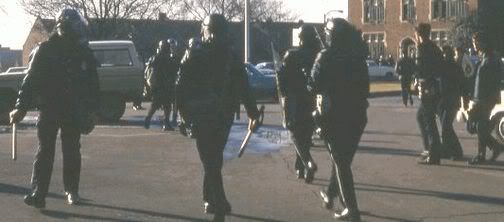
Eventually most of the charges were reduced from felonies to the misdemeanor of Obstructing the Entrance to a Public Doorway on every participant except Peter Kami the frail Brazilian who challenged Ed Boling to an arm wrestling match. Poor Peter was forced to flea the country over this event His life was put in peril over a harmless bit of theater because he dared to register his protest and speak his mind here at the largest University in the South. Since Peter was foreign he fit the description 'outside agitator' and his last name could rhyme with 'COMMIE'. Wrong name, wrong place, and wrong time Peter. We don't treat our foreign guests well here Peter, particularly if they have the gall to think our freedoms apply to them.
I have little to complain about because I'm still here and I didn't even pay the $25 fine imposed for my non-infraction. But the events of Jan 1970 made me a radical in a land where 'freedom of speech and assembly' are empty and hollow terms even on the campus of a University. The fear and paranoia of local Republicans shown in their massing of 100 cops to quell a small protest rally is in a large part responsible for what happened in the 70's all over the country. The high minded idea of FREEDOM wasn't really enjoyed in AMERICA when REPUBLICANS are in control.
As a result of that arrest my Spring quarter at UT involved a lot of fund raising for defense of the KNOXVILLE 22 - in the time of the Catonsville 9 and the Chicago 7 we had our place and number - and a run for President of the Student Body - a race lost when the Radical (me) and the liberal split the vote and elected the standard frat guy John Smith. That turned out to be interesting when the big show rolled into Knoxville in the end of May.
HOW NIXON USED THE MEDIA AND BILLY GRAHAM TO RAP TO THE STUDENTS AT TENNESSEE. - title by GARRY WILLS subtitle JESUS WEPT
Time and events conspired that Spring to force Richard Nixon into a trip to Knoxville. The massacre at Kent State and the bombing of Cambodia had brought the anti-war effort to a crescendo and the campuses across the country to a screeching halt.
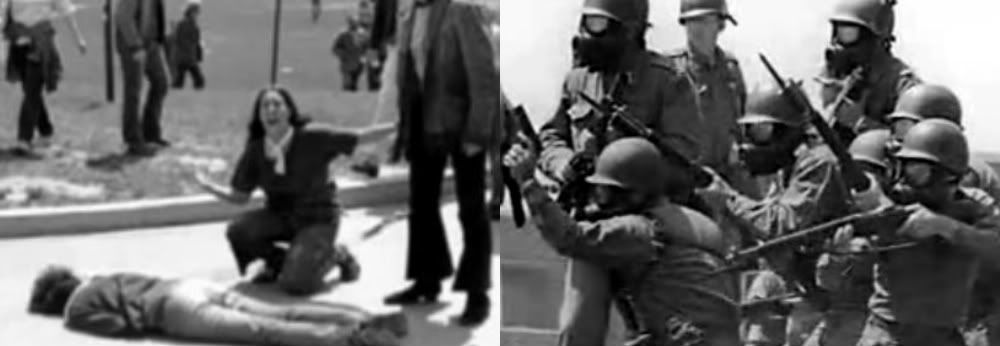
Nixon wanted to show that he was welcome on a college campus somewhere - anywhere. And when it was discovered that his good friend the Reverend Billy Graham was holding a crusade in Neyland Stadium on the campus of the largest University in the south during final exam week the prospect was just too good to pass up. It would also serve as a campaign stop to bolster the chances of the opponent of his nemesis Senator Albert Gore Sr who now openly opposed his war.
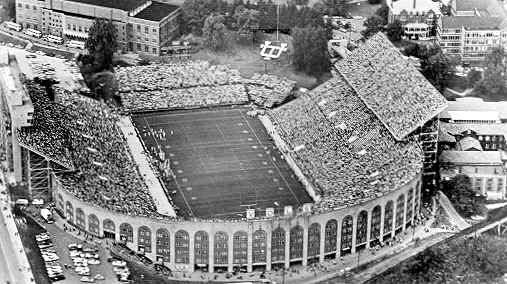
Never mind that the stadium would be filled with bus loads from outlying churches instead of students. The stadium was on the campus and the students would be cramming for exams or on their way home for the Summer with their exams behind them. Surrounded by good Christian Republicans from East Tennessee the threat of any demonstration was minor and this would be a religious service where he would be at worship. Never mind that the platform would host the entire Republican state Congressional Delegation without a single Democrat in sight and feature prayers for the success of his war policy.
As the recently defeated candidate of the left for Student Body President it fell to me to help organize some kind of protest to the NIXON visit. Luckily there were many who shared my disgust over the sham appearance including several prominent members of the faculty including Dr Richard Marius
who later moved to Harvard, and Dr Charles H Reynolds the head of the Theology Department (who's son you may know as the INSTAPUNDIT )
We put together a plan for a silent demonstration inside the stadium as part of the Crusade audience. I helped print up several hundred small signs that read simply THOU SHALT NOT KILL. Afterall who could object to a commandment at a religious service?
We gathered at the Student Center a few hours before the stadium would open and the speakers including myself urged the demonstrators to be respectful and silent and allow our signs to make our statement. We talked about going down on the field when Reverend Graham made "the Call" and holding up our signs or our hands in the PEACE sign.
One hour prior to the opening of the stadium we moved about 600 strong to the concrete interlocking U and T - a gift to UT from my fraternity when I was it's President seen in the stadium picture above. Everyone remained calm and orderly as they opened the gates.
At that point the problems began. Knoxville and Campus Police did their best to disrupt our orderly entry to the stadium. When they saw our THOU SHALT NOT KILL signs they ripped them out of our hands. Only a small number made it to the stands hidden inside clothing. A student who had our bull horn was handcuffed and dragged the length of the field to the roar of approval by the "Christians". It was like the Biblical Christians and lions in some bizarre reverse.
This youtube vidio shows a fleeting glimpse of the demonstrators who managed to get their signs into the stadium at the 1 minute mark of the 3:22 video

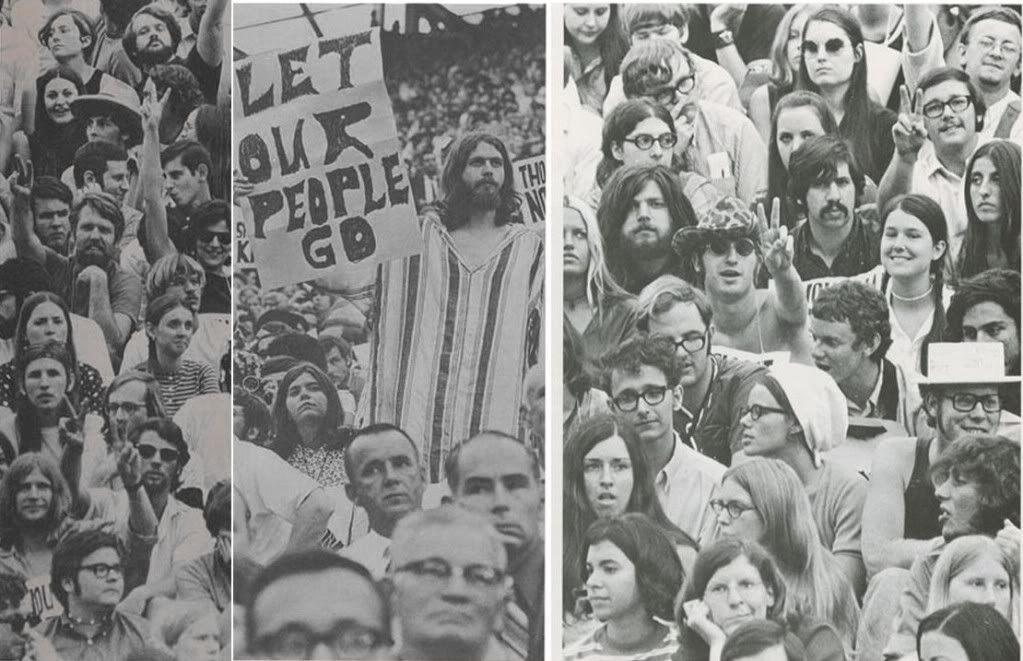
I INTERRUPT MY NARRATIVE HERE TO OFFER THE RECOLLECTIONS OF THE MAN YOU SEE IN THE PICTURE ABOVE WITH THE STRIPED ROBE AND "LET OUR PEOPLE GO" SIGN - Mr William Carroll Bible:
The Billy Graham Crusade, May 28, 1970, Neyland Stadium, Knoxville, TN
Was it a political or religious event?
For me it was religious.
The robe had been brought to the student government office where people were preparing for the demonstration. It was offered for me to wear, with the suggestion that I needed a robe since I 'looked like Jesus'.
Jesus? I balked inside myself, but decided to wear it anyway. That my zen of intersections should come in the form of a Biblical robe is not surprising. I had spent the past decade on a spiritual quest. In 1961 I had answered a call in Montreat, NC, by missionaries from Brazil to live and travel in Brazil to learn about the church's mission work. After high school graduation I and seven others spent a school year on this quest. My plans after Brazil included a church-centered college and a resolve to return to Brazil to serve as a missionary. I had been prepared for this journey with the mind set of duck-and-cover vigilance against the (Communist) enemy. I had been Cadet Colonel in Jr. ROTC. My father worked for the federal government. I understood Law and Order from the inside out.
The assumptions behind my life plans may have been naive. Some of us were rabbits on the tracks and locomotives were rumbling nearby. Trouble for me began in college when I evaluated my experience in Brazil. I could see that our high standard of living was built on the backs of others' suffering, enforced for corporate gain. I understood the same thing was happening as well in Viet Nam. During this transition the intensity of my private spiritual life remained central, even as religion fell from my conversation and I abandoned the mission plans in exchange for a study of History at UT's graduate school. By the time of the crusade my spiritual life, along with the rest of existence, had become totally focused by the war, its evil nature and lies. Accepting the emerging truth about the nature of Power was destroying the childhood framework that held my world together, creating a vacuum of authority.
Today, distrust of government is taken for granted, not something to shatter one's foundations. But my world then was cracking as I tried to reconcile my Christian faith to my country's role in history. It was a deeper concern for me than the rumble gathering on the tracks, and I sacrificed much for it.
A Biblical robe needed its own sign. The preprinted signs read "Thou shall not kill". I wanted a sign that read, "Let our people go", a reference to the Knoxville 22 (arrests) from an earlier protest on campus, and for all the other political prisoners around the country. I changed Moses's quote to 'our' because they were not 'my' people.
Using a quote by Moses was a step away from comparison to Jesus. But Moses didn't fit me any better. He led his people. Communication and interpersonal skills are required of a leader; I was blessed with an abundance of neither. I was better suited to see large patterns in history than to connect effectively with individuals. I know as people grow old they may not remember everything about the past, but I'd be surprised if anyone remembers me as a leader in those protests of 1970. I was the street-theater element -- independent, stamped by my personal quest, not necessarily relevant to the group's plans.
At some point the phone in the office rang. It was a national radio show wanting an interview. Apparently, nobody wanted to talk to them, so I did. I explained the need to oppose Nixon's appearance on campus under the circumstances. The reporter then asked if I didn't fear arrest. I said I didn't see any reason for arrests to be made. I was sincere in that.
I dressed and folded the sign under the robe to secret it past the sentries at the gate.
Once inside the stadium, I fell under a spell of reverence for the enormity of the event. I remember holding the sign up, and wanting to stare a hole through this evil President. It was a contempt spawned by the betrayal of an innocent faith in my country, made worse because the lies were cloaked in patriotism.
The protesters that day exercised free speech during the political parts of the rally, but practiced no violence. The call for violence that I recall came from one of the singers of a spiritual hymn when she expressed a desire to come down and give us a smack. Exactly what effect that was meant to have on an angry crowd of 90,000 hungry Christians who gladly would have fed us to the lions on the spot, only she can say. I was to feel some of its impact soon enough.
A lot of influences led me into Neyland Stadium dressed in a robe. But there was a common prime mover for everyone protesting that day, on both sides. The war was the bullying of all young people by cynical liars. I understood the lies as a student of History. But those who had no choice but to go to war were the greatest victims, regardless of their attitude about their roles. If their parents were sitting in the stadium that day and saw the protesters as a lightening rod to channel their own anger, then I can't hate them for that. They were in the same position as I -- twisted into circumstances they could not control -- we were all small people in the presence of Power.
Everyone present was transfixed by the moment. Everyone was equally human, living from moment to moment in the space they occupied, just as they were called to do. That included Billy Graham. We were on opposite sides of truth that day, but I have nothing but respect for Dr. Graham today.
When Nixon quit talking and the protesters followed suit, I walked from the stands onto the field to listen to Graham. I had come from an intensely religious background and wanted to communicate my faith by clearly, obviously, paying attention to Graham's words. I sat on the ground at midfield and listened intently to the sermon. Likely, no one caught my drift.
When Graham finished speaking I stood up to leave the stadium. As I left the field. I was met by a uniformed officer and arrested. The spell was broken. I began yelling to the nearby spectators, "They're taking political prisoners!" That earned me a club across the knee -- a smack of sorts, set to a hymn no doubt, intended to cause permanent damage I bet. My knee cap, however, hidden by the robe, survived by an inch.
Once in my cell, I asked that Billy Graham pay me a visit. I wanted to hear his rationale for sponsoring Nixon. That doomed request marked my final break with organized religion. As it sank in that he would never come to my cell, the vacuum of authority split apart at the seams. The phantoms of both 'law and order', and the moral authority of the church stood before me in that vacuum, both hollow of soul. After that, I resolved to take my quest for God on the road, to find whatever truth that comes into my life in the future without appeal to church or state.
Less naive after the crusade, I watched as Power's war on its people limped on for more unnecessary, life-crushing years. More souls were torn apart; lives were lost. The unimaginable horror suffered by the Asia people we don't even want to know. Today I am not surprised that in the new century Power has established a permanent war on its people and their civil liberties, with the blessings of the majority.
Looking into my jail cell that night in 1970, any student of the Bible should recognize the Biblical character I really resembled. I hadn't planned it, but I was in the role of an Old Testament prophet -- an outcast, despised for a message that was too harsh to accept, truth that would challenge a certain moral comfort. All of those people in the stands that day hating the protesters were playing their role too, just as it is in the Bible.
Since most of the signs were confiscated and demonstrators were being subjected to some rather vile comments and shouts from the assembled "Christians" the idea of a silent protest soon fell apart when Nixon took the podium. Police photographers took pictures of the protesters and police filled the sidelines in front of the protester section. Nixon's words were not drowned out by the small group of protesters but they were overwhelmed by the 90,000 Christians who successfully shouted the protesters and Nixon down.
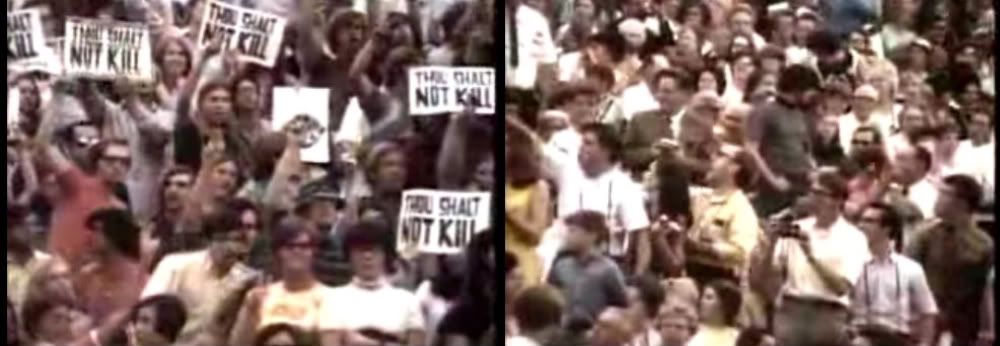
HERE is what GARRY WILLS had to say about the events and my participation:
"Knoxville police, looking about for applicable laws, had found one to protect him from "political" dissent. Tennessee statute TCA 39-1204 forbids anyone to disrupt a religious service. That would allow cops to take away political placards, ban any political shouts (even those for Nixon), expel all who indulged in politics during "the service" so much for outside agitators. For inside ones, the police had another inhibitor. After a disturbance on January 15 of this year, police had identified and arrested some of those present, with the help of photographs; now they would ostentatiously shuffle those same photos while taking new ones, pointing (pointedly) at known campus radicals; promising, by that simple act. more arrests of the January 15 sort. Just to make sure that the nonpolitical nature of the meeting was understood, the campaign manager for Republican senatorial candidate Bill Brock, on the night before Nixon's appearance, talked with a Nixon advance man, Dick Andrews, and told Y.A.F. people not to bring their placards to the stadium—instead to line the motorcade route with them.
Would the plan work? Secret Service men, after careful soundings, decided that it would. After all, this was Big Orange Country. The school belonged to the community, which belonged to the First Baptist Church, which was heart and soul (if only he would have them) devoted to Billy, who is servitor and celebrator of any President (of power), but especially of his friend and fellow addict of success-religiosity, Richard Nixon. Town, gown, bank, church, and Crusade were of one mind. Even the Mayor of Knoxville addressed the Crusade, sang in its choir, and acted as counselor to those coming out of the stands, after Billy's sermon, to make their decision for Christ on the rubber turf. He also issued a proclamation to all city employees, telling them to renew their commitment to God. The police chief's daughter told the Crusade why she was an American. A high-school graduating class held its baccalaureate service at the Crusade, in its gowns and mortarboards. If this was not Nixon country, then what is?
But what of the university's own students? Would they join this universal hymn of praise to God and Nixon? The question hardly crossed local people's minds. The U.T. product was well-known—the perfect fraternity man, the perfect sorority girl. Call them Ken and Barbie— they were mainly wardrobe. "The first thing we did to a pledge," one senior remembered for me, "was grab his shirt by the collar and look at his label. London Fog coats, Gant shirts, Canterbury belts, Haggar slacks, a red carnation on one's blazer, three-piece suits— that's what we looked for."
It made a pretty package, whether male or female. Barbie, for instance; Tricia Nixon corn-fed to pleasanter roundnesses—a Tricia with a body, as it were; and with the same fixed smile, the lidless doll-gaze, to proclaim unassuming dutifulness. Barbie is pretty, glib, obedient, glowing—every Big Orange footballer's patriotic wet-dream.
Or Barry—Barry Bozeman. His father, a local politician, was the university's head of student activities as an undergraduate; his mother was editor of the school paper and a Torehbearer (one of the all-round top-seven seniors). Barry had not missed a single home game since he was six years old; he had acted in the university's theatre for children. Easily, with no effort, he became president of his freshman class (in which capacity he led a demonstration in favor of the Vietnam war), president of his fraternity (Phi Sigma Kappa). Pinned for a while to the Phi Sig National Moonlight Girl, he returned to his high-school sweetheart, the storybook ending. Another perfect product, Ken-Barry matching Barbie-Sue, ready to be set up like a trophy in some cushioned Knoxville office. But what happens when Perfection displays a crack or a flaw? Terrible things in Knoxville and that’s what happened with Barry, last fall, while he was working as a booking agent for a rock band, he began to let his hair grow. All his father's friends noticed, and whispered, and his father noticed their whispers. Which led to an ultimatum by Christmas—cut his hair or get out of the house. Barry got out; got arrested with twenty-one others in the January 15 campus disturbance; joined a March Against Repression led by Jerry Rubin, in Nashville; ran—and ran strong— as a radical for Student President this spring. Something bad was happening on campus.
So Barry, once the rah-iest of rah-boys, was there, with two hundred others, on the day before Nixon came, plotting ways to show student disapproval of his coming. It was a small group but influential, containing most of the active politicians on campus. Even the new Student President, a conservative, was there—John Smith. The Student Government Association used to belong to the fraternities, but changes had been taking place across the last four years. John Smith, Barry's Phi Sig brother, barely squeaked in when the school's Left vote split between the "radical" (Barry) and a "liberal" candidate."
You can read the entire excellent article by GARRY WILLS right here
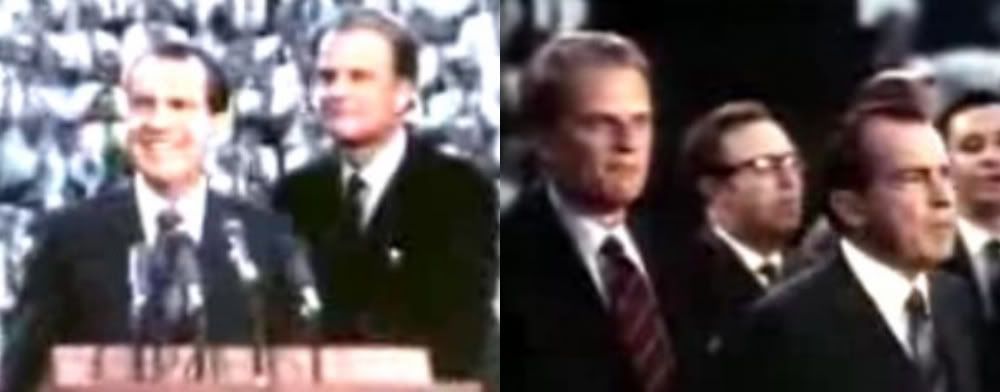
Once you've seen the video and read the GARRY WILLS article you will see that our protest didn't have much effect. Nixon and the media left the impression that Nixon had indeed gone on a major American Campus and was welcomed. But we tried and for our efforts 57 arrest warrents were issued and served for people who dared to take THOU SHALT NOT KILL signs to a religious service. They were charged with DISRUPTING A RELIGIOUS SERVICE. A religious service for only the Republican Right in the Rightwing Republican city of Knoxville. Their convictions were appealed to higher courts until they were eventually overturned.
For me these events represented a final stage in change from my original ambition to serve my father's wishes that I enter politics and run for Governor. Instead I left for Canada on the eve of Nixon's reelection in 72 despite my lucky lottery number because I refused to live in a country that would elect that him twice.
If you happened to be in Knoxville around that time I am collecting the recollections of participants in these events for a website and a book and I would love to hear from you via my FACEBOOK page
If all of this hasn't satisfied your thirst for East Tennessee politics read the Faculty Report on the events involved HERE The Faculty did acknowledge that the confiscation of our THOU SHALT NOT KILL signs was regrettable.
You may also find a few pages of BILLY GRAHAM: A BIOGRAPHY - ON THE NIXON VISIT - interesting:
THIS IS THE SECTION OF THE BILLY GRAHAM BIOGRAPHY INVOLVING THE NIXON VISIT TO THE KNOXVILLE CRUSADE AND THE PROTESTS.
120This diary was a lot of work and I would be most appreciative of your recommendations and comments.
BILLY GRAHAM
To the president, the University of Tennessee seemed a relatively safe place to break out of his relative isolation at the White House. This , after all was not a campus known for its political progressivism or notable for its anger at the war in Vietnam. It is true that following the news of Kent State a large contingent of students, along with a number of professors, had boycotted classes and that some 1,500 protesters had marched to the campus field house that housed the ROTC offices It si also true that student had lowered the flag to half staff in honor of the student slain at Kent State.
Nevertheless there had been no extensive violence. Nixon felt generally comfortable in the South, where his popularity remained relatively stable and where his wartime policies were supported in greater numbers than in any other part of the country
For the 5I-year-old Billy Graham. lean and youthful-looking with side-burns and over-the-collar hair, the Knoxville crusade was another chance to echo the themes he had pursued in other recent meetings — that the youth of America, hungering for identity and sense of family, could rally around a revolution for Christ.
The first days of the crusade in Knoxville featured music legends Johnny Cash, Cart Perkins, and the Carter Family. Although a few pro-testers mingled outside the stadium handing OUT antiwar leaflets, those who attended the crusade were treated to what they had come to hear — a rousing evangelical show, capped by the inimitable Billy Graham Sermon.
On May 27, It all changed. The announcement of President Nixon’s VISIT a day before the event was a last minute surprise, even to Graham. The president decided the crusade would be a perfect way for him to connect to the people at a time of devastating national tension. He would become the first sitting President ever to speak at a Billy Graham Crusade. Excited but apprehensive about the President’s appearance, Graham said to a reporter, There will not be anything political— I hope 0 in this visit. :
The announcement that the President would make the University of Tennessee his coming-out event enraged antiwar protesters on campus. And they reacted quickly. Aided by several university professors, student protesters decided to carry signs printed "Thou Shalt Not Kill" and "Peace Now* Knowing that the national media would hone in on the event, the planners decided not to heckle or chant. Fearing that such a demonstration would alienate many from their cause. After all, the crusade was supposed to be a religious event. They decided to join in the throng when Graham called for converts but they would bow their heads and make the two fingered peace sign gesture. It was to be a silent, nonviolent protest.
Susan Nixon, editor of the student newspaper The Daily Beacon, wrote an editorial that began. “Billy Graham’s one-man circus has everthing except an elephant. And now he has one of those.";
The student newspaper announced the planned demonstration and a printed a telegram sent to President Nlxon by organizers that declared. "We are angered by your announced presence on this campus and we are
MIXING POLITICS WITH EVANGELISM 121
outraged that you would capitalize on a religious function, particularly in the South.
May 18, 1970, was unlike any day ever seen at the University of Tennessee. The contrasts were striking, This was a religious gathering Yet, on the stage at the 20-yard line were President Nixon and his wife Pat, Billy Graham, Senator Howard Baker, Congressman John Duncan and Knoxville Mayor Leonard Rogers Among them, only the Reverend and the First Lady held no elected political office.
In the stands were Presidential advisor HR Haldeman, Presidential friend Bebe Rebozo Presidential secretary Rosemary Woods, Secretary of Commerce Maurice Stands, and the Presidents chief foreign policy advisor Henry Kissinger. In the crowd were dozens of protesters, many wearing garments fit for a depiction of Galilee in the time of Christ. Indeed one of the protesters, with a long beard and hair and wearing a white robe with sandals looked as if he were ready to play the lead part. On the field mixing in with the demonstrators were dozens of Knoxville police and members of the secret service from Washington protecting the chief executive from the motley group. Their signs reading THOU SHALT NOT KILL had been confiscated before they had entered the stadium.
As Graham began his introduction of the President, demonstrators chanted "Politics! Politics!"1 When Nixon rose to speak a number of demonstrators began chanting antiwar slogans, only to be drowned out by a roar of pro Nixon boos. When the President began he said that being in the football stadium reminded him of his four years on the bench at Whittier College. Quickly the address began to sound as if the President were running for office Only a few remarks about spirituality invaded his string of political references., His remarks were not as forthright a witness for Christ as I had wished for, Graham later recalled, “but I rationalized that he was extremely tired from carrying many burdens”
Before the actual religious service began, most of the protesters began to file out singing the John Lennon song GIVE PEACE A CHANCE. Some stayed throughout the service and, adhering to the original plan, stood with bowed heads and flashing Peace signs. Photographers milled around the crowd taking pictures of the demonstrators. Police arrested nine and charged the with the crime of disrupting a religious service. A state law that none of the arrested even knew existed.
The following week police made the rounds of the University of Tennessee campus arresting those students and professors whose faces showed up in the photographs. Eventually most of the charges were dismissed when judges agreed with the defendants that Nixon’s speech was not a religious one.
In reporting the University of Tennessee debacle much of the national press was kind neither to President Nixon nor to Graham, asserting that the event mixed politics and religion in dangerous ways. Journalist and author GARRY WILLS, for example, wrote a piece for ESQUIRE MAGAZINE entitled “HOW NIXON USED THE MEDIA, BILLY GRAHAM, AND THE GOOD LORD TO RAP TO THE STUDENTS AT TENNESSEE U”
No comments:
Post a Comment